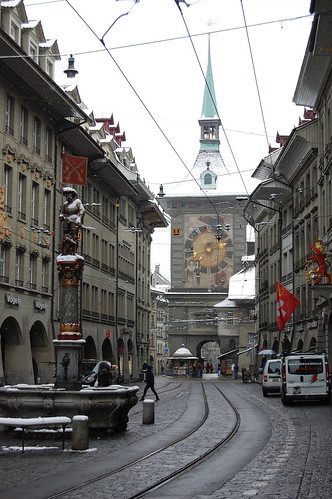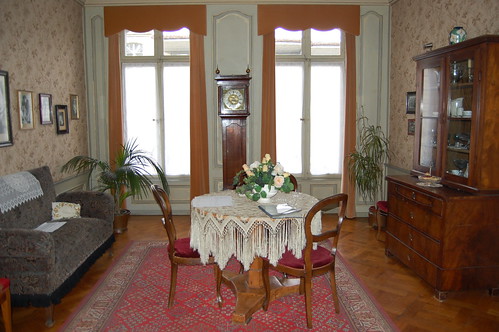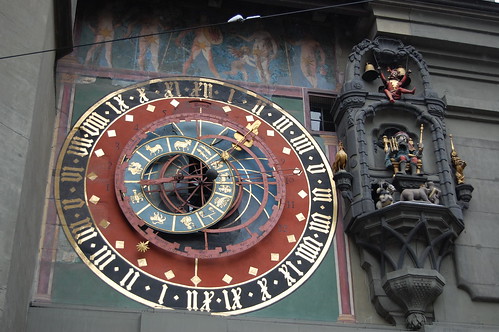“Annus Mirabilis”
- By Faith Tucker
- June 18, 2010
- 6 Comments
Dear Blueshift readers, you don’t know me; let me introduce myself. My name is Faith, and I’m a part of the small herd of undergraduate interns that descend on Goddard Space Flight Center each summer. While most interns will be spending their summers participating in exciting research projects with Goddard scientists, I have the pleasure of working with the Blueshift team here to bring you the inside scoop on what’s going on at Goddard and within the broader astronomy world. Before coming to Goddard, I spent 4 months traveling rather extensively through Europe, parts of the Balkans, and Japan. And being something of an astrophile, I found my way to a number of fascinating astronomy-related sites in the process, so keep your eyes open for some of my adventures!
This first one comes at you from Bern, the capitol of Switzerland, buried deep in the heart of Western Europe. Unlike its more metropolitan cousins, Zurich and Geneva, Bern has retained its medieval charm, characterized by ubiquitous greenish grey sandstone buildings and nearly 4 miles of arcades (covered sidewalks), all surrounded by extensive city walls and embellished with bear figurines everywhere (Bern’s traditional symbol). The fact that Bern still looks nearly exactly as it did 500 years ago makes it one of Europe’s best-preserved medieval cities and has earned it the title of a UNESCO World Heritage site.
Though fascinating, Bern’s archaic history is not what warrants our attention just now. Very nearly hidden along a busy thoroughfare in Bern’s oldest part of town, the observant visitor will find a special gem of science history: the otherwise unassuming apartment in which Albert Einstein lived while working at the Swiss Patent Office. What’s more, it was in this cozy apartment that Einstein composed and published four career-defining papers that would go on to shake the foundations of the physics world. All this he did in his free time! Einstein can make me feel unproductive even from his grave. These papers included his work on Special Relativity, Brownian Motion, the Photoelectric Effect (for which he won the 1921 Nobel Prize in Physics) and Mass-Energy Equivalence (E=mc2!). All four of these were published in 1905, his ‘annus mirabilis’ or ‘miracle year,’ from right here in Bern!
The Einstein Haus is composed of two floors. When you ascend the steep spiral staircase to the second floor, you’ll first find yourself in the living room of the apartment, the walls of which are adorned with old framed photographs of Einstein and his family as well as assorted documents, such as his high school diploma and personal letters to his wife Mileva. Standing there I could just picture him hunched over his desk scribbling madly, probably muttering about Lorentz transformations. From there, you can climb up another level to the third floor of the apartment where a film detailing Einstein’s life and work is playing and an exhibit explains some of his most famous discoveries.
For a much more extensive look into Einstein’s life and work, make sure to check out the Einstein Museum in Bern’s History Museum. But be forewarned, when I say ‘extensive,’ I mean absolutely exhaustive. Case in point: the exhibit begins by chronicling the saga of the Israelites as a tribute to Einstein’s Jewish roots and moves on through history from there. It took me almost two hours to get through the entire thing while reading much less than half of its thorough explanations. It’s well worth the time though.
Einstein’s legacy may be Bern’s highest-profile astronomy related attraction, but it’s not the only one. The Zytglogge (Swiss-German for Clock Tower) dominates Bern’s Old Town area where it is perched along one of the old city walls. As Bern grew between the 12th and 14th centuries, a series of concentric city walls and motes were constructed to enclose the expanding township. This left the Zytglogge, which was once used as a prison before being converted into a clock tower, at the center of action in town.
Caspar Brunner installed the clock in 1530 with two clock faces. On top there is a standard clock face, but just below you’ll find an impressive and beautiful astronomical clock that displays the position of the sun in the zodiac, the day of the week, the month and year, the phase of the moon and the elevation of the sun above the horizon. All of this is superimposed on a 24-hour clock face showing the time.
The fact that the clock has been running smoothly since the 16th century is incredible by itself, but perhaps equally striking is the animatronics display conjoined to the clock – an astounding piece of engineering for its time. Chronos, a Greek mythological figure who personifies time, sits atop his throne and flips his hourglass to signal the passing of another hour. Below him a parade of bears march around, a rooster crows, and a jester rings bells. By today’s standards the show may not be worth how foolish you’ll feel standing in the middle of the busy square staring up at the tower waiting for the hour to turn and thus self-identifying as yet another tourist, but the fact that this spectacle has happened every hour for almost the last 500 years makes it a moment worth savoring.
That’s it for now, but check back next week to learn more about astronomy history and research taking place all over the world!







[…] Blueshift have stuck up another tour, this time of Bern, Switzerland, Einstein’s home at the time of his publication of four seminal […]
I love the pic of you and Einstein! Great pics and great blog entry! :-)
Faith- I just came across your email again and decided to check out the blog. A beautiful job and I can’t wait for the next one!!
Here you are smooching that guy, and it’s not clear you’ve been properly introduced! Lovely post and it’s great to see Bern again.
Wonderfull year? or 1666 – The year of wonders?
:
Einstein – A true legend, that word gets thrown around to much now, it was only a while ago I learned about his past, funny how peoples lives can change.